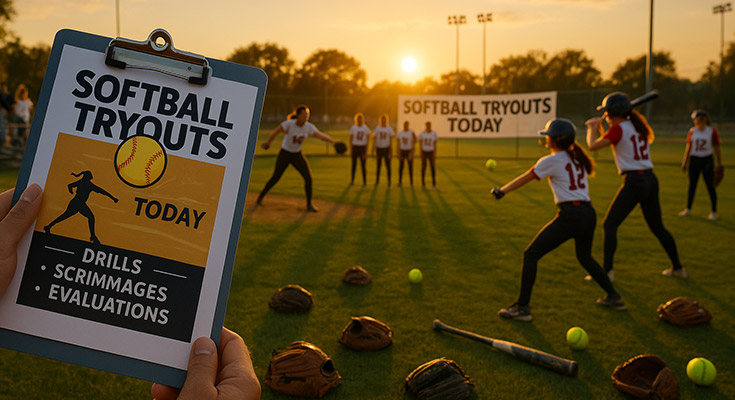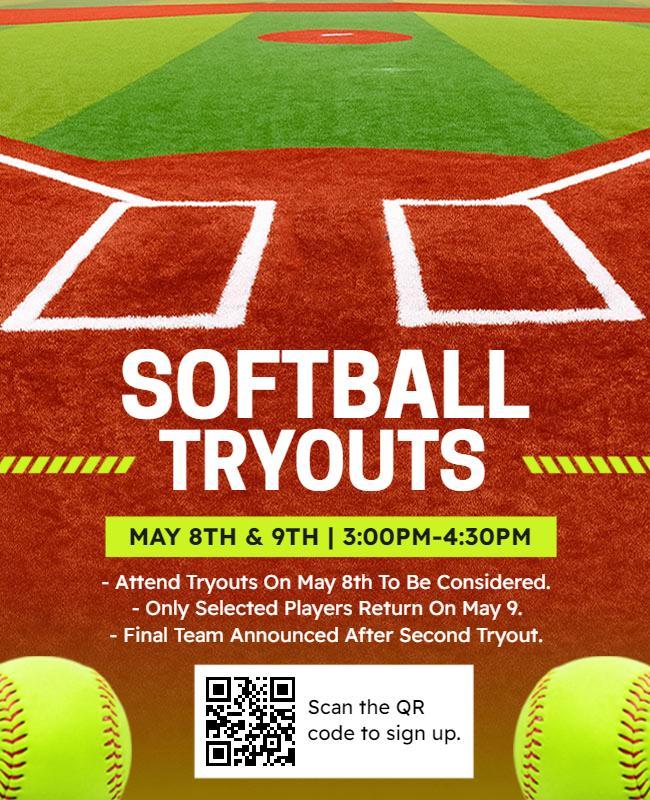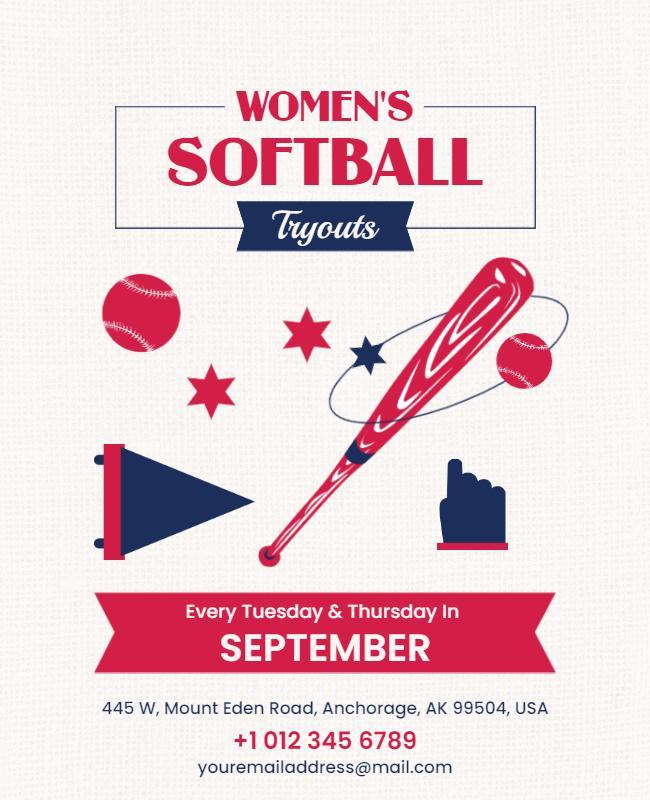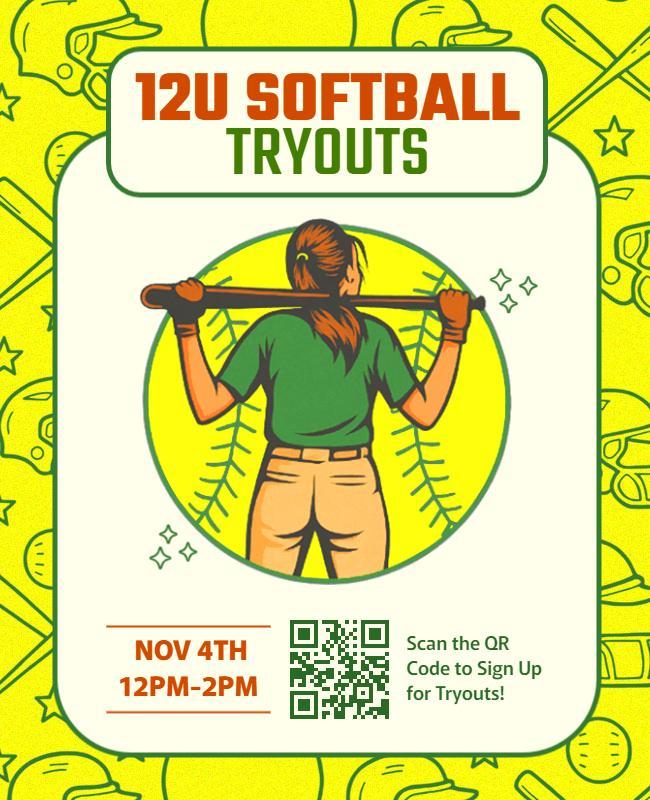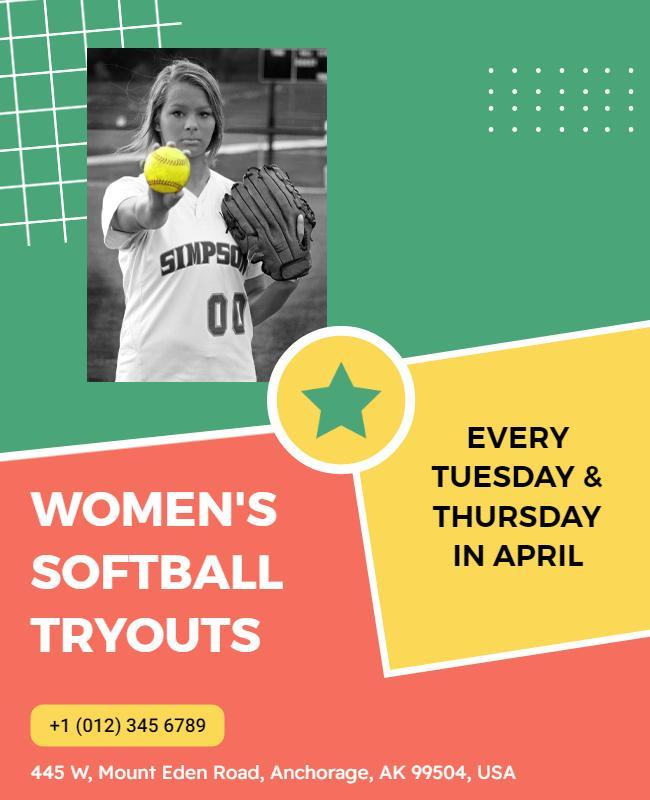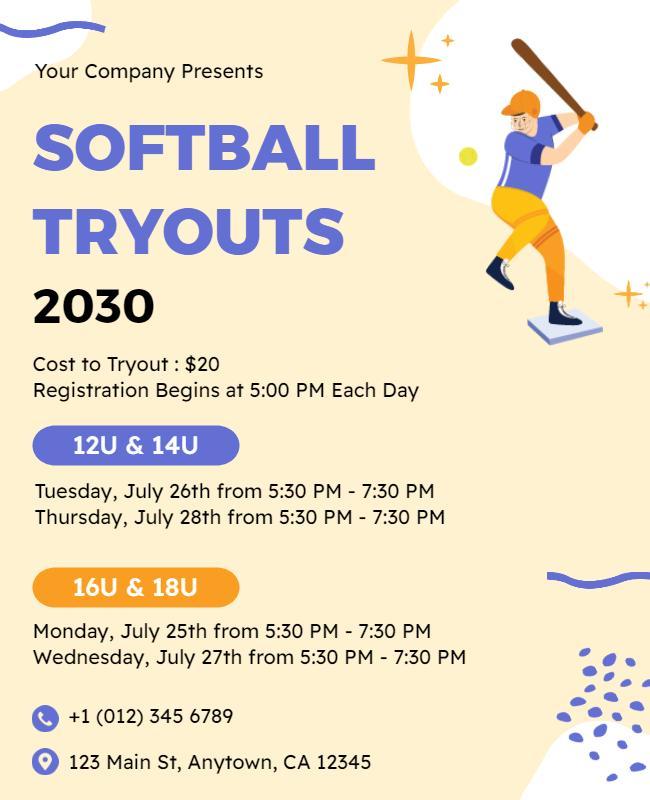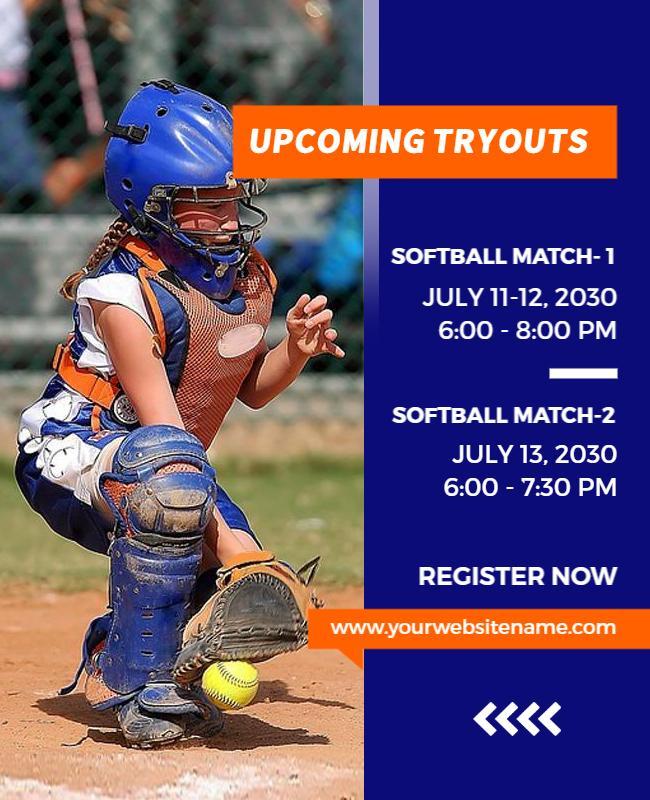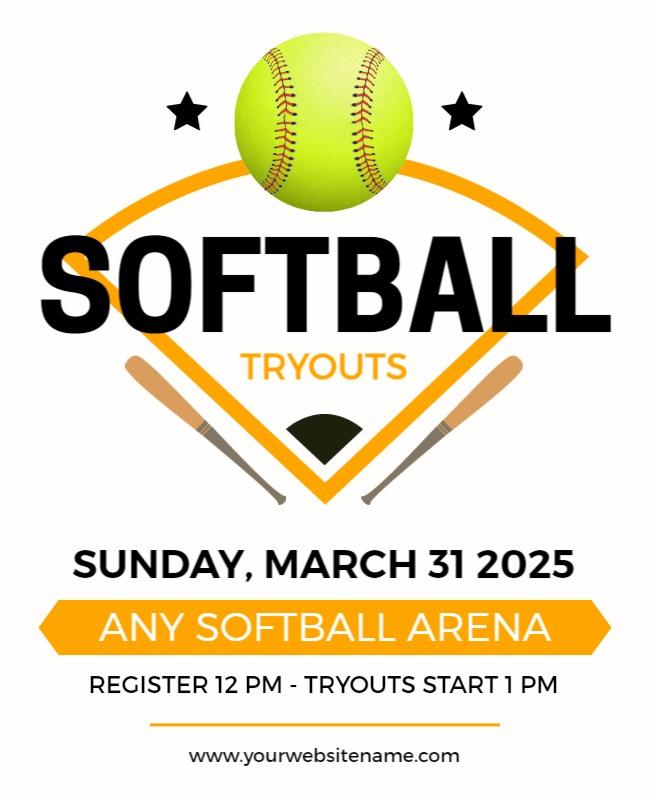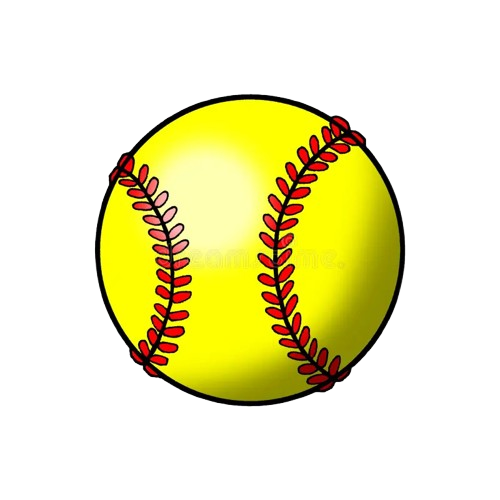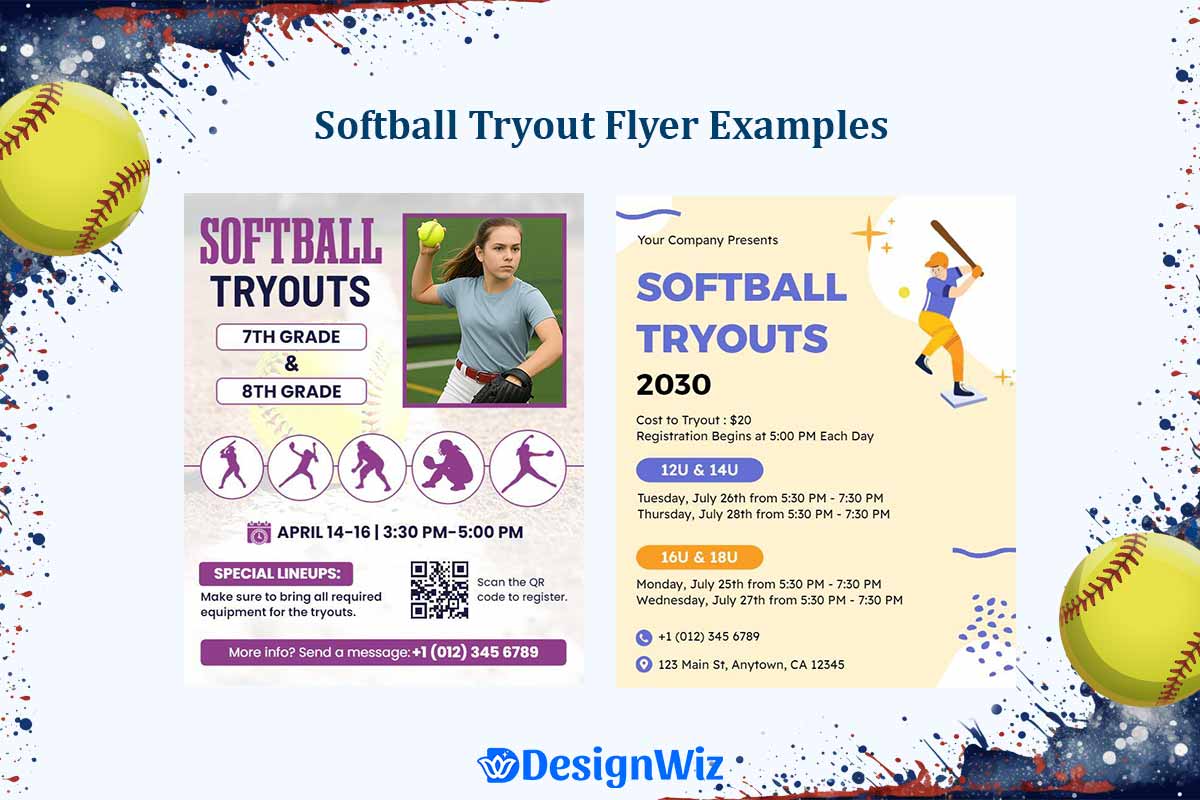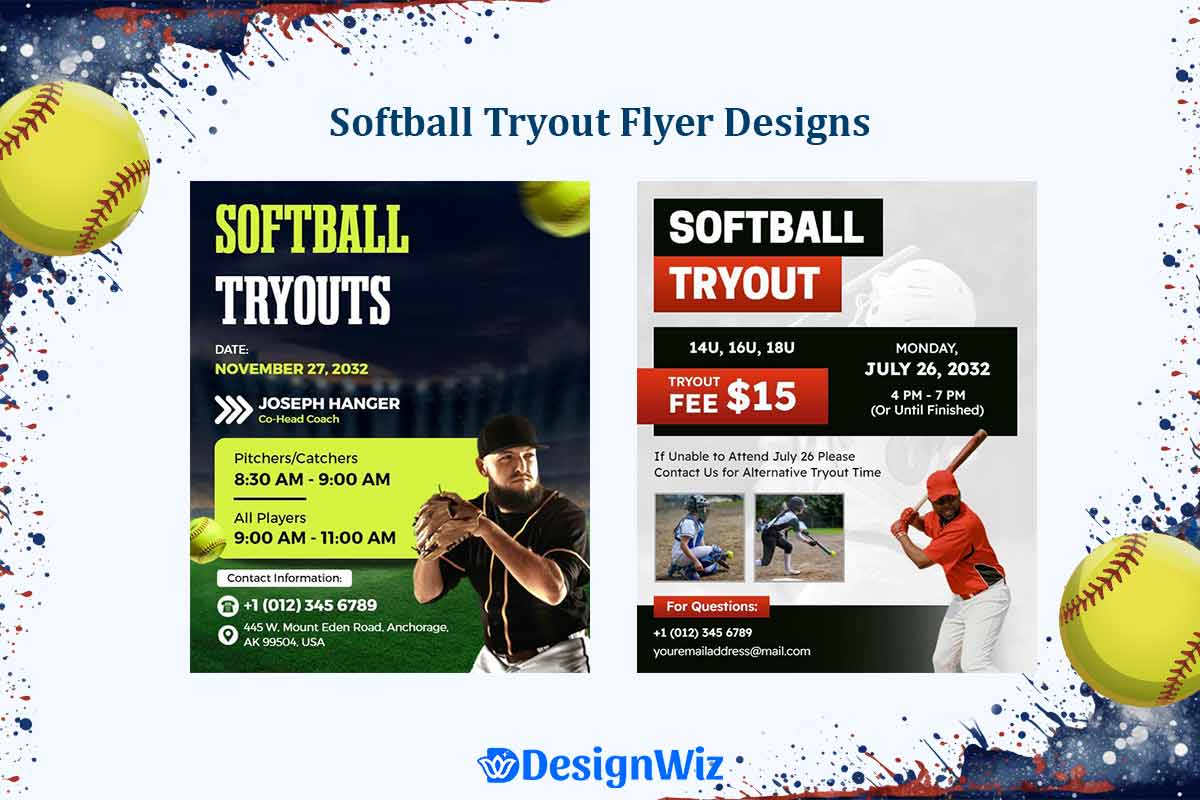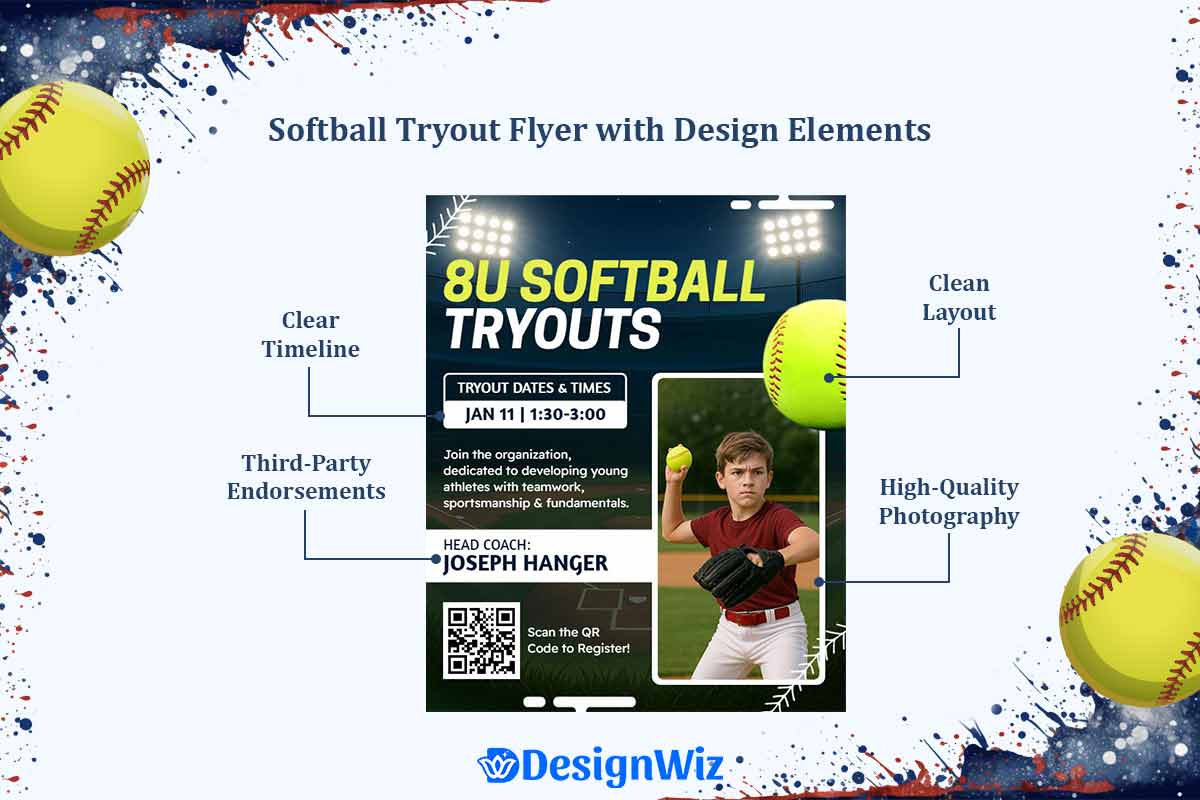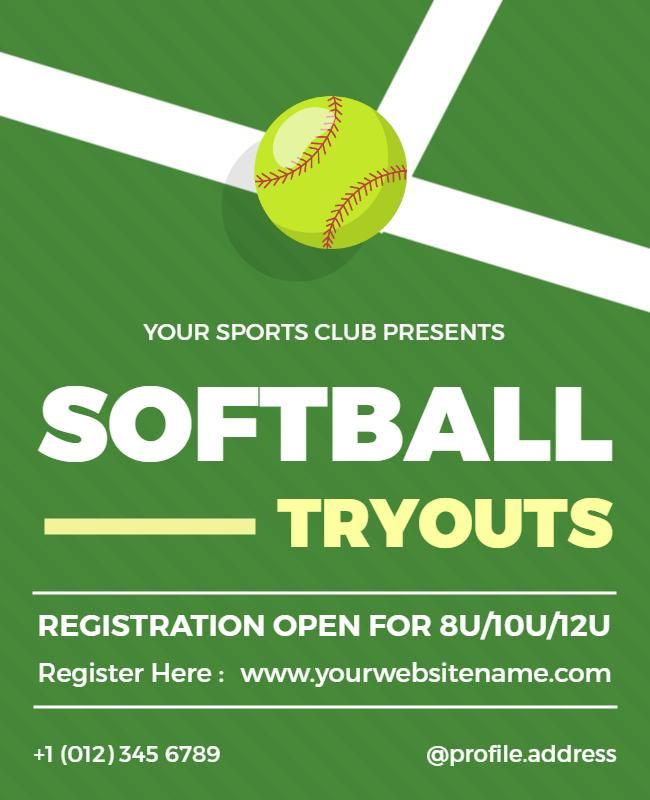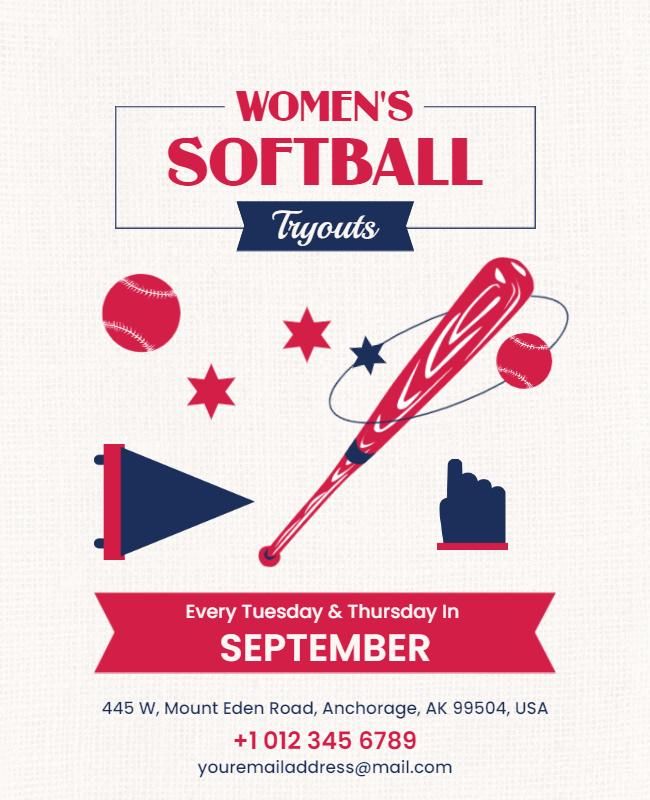Use ready-made softball tryout flyers that stand out—clean, bold, and built for competitive recruitment.
Tryout season creates unique pressure for coaches: you need to evaluate 40+ players for 12-15 roster spots while ensuring you attract the best available talent in your area. Your flyer is often the first impression serious players have of your program and it directly impacts who shows up to compete for spots.
The numbers reveal the challenge. Average Softball Tryout Flyer reach 200+ potential players but only convert 15-20% to actual attendance. Top programs achieve 35-50% attendance rates and consistently attract higher-caliber players through strategic flyer design.
Why Softball Tryout Flyer Fail to Attract Top Talent?
Common messaging and design gaps often prevent softball tryout flyers from connecting with serious, high-level players.
Unclear Skill Level Expectations: Generic language like “all skill levels welcome” attracts quantity over quality. Serious players need to understand competitive standards and program expectations.
Weak Program Credibility Indicators: Without clear coaching credentials, facility quality, or player development track records, your program appears amateur compared to established competitors.
Poor Logistics Communication: Complex tryout processes, unclear evaluation criteria, or missing practical details create friction that discourages serious player participation.
Generic Messaging: Cookie-cutter tryout announcements fail to differentiate your program from 5-10 other teams holding tryouts simultaneously.
What Should You Include on a Softball Tryout Flyer?
Effective softball flyers address the specific concerns serious players and parents evaluate when choosing which programs deserve their time and commitment.
Essential Tryout Information Checklist
Make your softball tryout flyer more than just an announcement give families the confidence to show up by clearly communicating what sets your program apart. Use the checklist below to include credibility-building details that inform and inspire.
Program Credibility Elements:
Parents and players want to know they’re choosing the right program this section highlights the credentials, history, and facilities that build trust and boost tryout turnout.
Coaching Credentials and Background:
- Playing experience (college, professional, competitive levels)
- Coaching certifications and continuing education
- Years of coaching experience and age group specialization
- Player development success stories and statistical achievements
Program History and Player Advancement:
- Years program has been established
- Number of players advanced to higher levels (high school, college, travel teams)
- League championships, tournament victories, recognition achievements
- Alumni success stories with specific names and accomplishments
League Affiliations and Competitive Level:
- Official league memberships and sanctioning body approvals
- Competition level and tournament participation history
- Regional, state, or national ranking information if applicable
- Scheduling examples showing caliber of regular competition
Training Facility Quality and Equipment:
- Field specifications, lighting, and professional maintenance standards
- Equipment availability (batting cages, pitching mounds, training tools)
- Indoor/outdoor practice capabilities and weather contingencies
- Safety equipment and first aid availability
Skill Level and Expectations Communication
Set clear expectations upfront to help players and parents prepare for every stage of the tryout process.
Specific Skill Requirements:
- Previous playing experience expectations (recreational, competitive, travel)
- Fundamental skill baselines (batting, fielding, throwing, running)
- Physical fitness and conditioning expectations
- Mental game and coachability requirements
Evaluation Criteria and Process:
- Specific skills being assessed during tryouts
- Evaluation format (individual skills, scrimmage, interviews)
- Multiple session structure and attendance requirements
- Scoring or ranking system explanation
Selection Timeline and Notification:
- When evaluation decisions will be made
- How players will be notified (phone, email, in-person)
- Waiting list procedures and callback possibilities
- Next steps for selected players (practices, equipment, payments)
Logistics and Process Communication
Ensure a smooth tryout experience by clearly communicating all logistical details from location and timing to gear requirements and safety info.
Multiple Tryout Dates and Times:
- Primary tryout date with backup options
- Session length and arrival/departure timing
- Weather contingency plans and communication methods
- Make-up dates for conflicts or cancellations
Location with Complete Details:
- Facility address with landmark references for easy finding
- Parking availability and overflow arrangements
- Check-in procedures and parent observation policies
- Emergency contact information and first aid availability
Equipment Requirements and Recommendations:
- What players must bring vs what will be provided
- Recommended equipment brands or specifications
- Uniform requirements for tryout sessions
- Water, snacks, and break arrangements
The Positive Coaching Alliance recommends that tryout communications clearly outline required equipment, evaluation criteria, arrival procedures, and expected behaviors, as these pre-tryout details significantly reduce confusion and help set a professional tone that supports player and parent preparedness.1
Read More: Complete Guide to Softball Flyer Design: Expert Tips & Best Practices 2025
How Do You Design Softball Tryout Flyers That Get Results?
Creating flyers requires understanding player psychology and competitive positioning within your local market.
Step-by-Step Softball Tryout Flyer Creation
Build a high-impact tryout flyer from the ground up with this structured approach designed to attract the right players and drive real turnout.
Step 1: Define Target Player Profile
Before designing anything, clarify exactly what type of player you want to attract. This shapes every design and messaging decision.
Competitive Player Characteristics:
- Previous travel ball or competitive league experience
- Demonstrated skill improvement and coachability
- Commitment to practice and tournament schedules
- Family support for competitive athletics investment
Development-Focused Player Characteristics:
- Strong fundamental skills with improvement potential
- Positive attitude and team-first mentality
- Willingness to learn advanced techniques and strategies
- Long-term commitment to program participation
Step 2: Establish Credibility Hierarchy
Present credibility information in order of importance to your target players.
Primary Credibility Indicators:
- Head coach playing and coaching background
- Program achievement history and recognition
- Facility quality and professional standards
- Player development track record with specific examples
Secondary Credibility Support:
- Assistant coach qualifications and specializations
- League affiliations and competitive memberships
- Parent and player testimonials from previous seasons
- Community recognition and media coverage
Step 3: Communicate Selection Process Clearly
Transparency builds trust and helps serious players understand program standards.
Evaluation Process Elements:
- Specific skills being assessed with relative importance
- Multiple session structure and attendance expectations
- Fair evaluation procedures and bias prevention measures
- Timeline from tryouts to final roster decisions
Step 4: Position Competitive Advantage
Differentiate your program from alternatives in your market.
Unique Advantage Examples:
- Superior facility access and training resources
- Coaching expertise and professional development opportunities
- Competition level and tournament exposure
- Player development success rate and advancement opportunities
Step 5: Simplify Registration and Contact
Remove barriers between player interest and tryout attendance.
Registration Optimization:
- Multiple contact methods (phone, email, online form)
- Pre-registration benefits and process explanation
- Clear next steps after initial contact
- Immediate confirmation and information provision
Player Psychology and Motivation
Understanding what drives players and parents helps you design tryout flyers that speak directly to their goals, concerns, and motivations.
What Motivates Serious Players to Try Out:
- Skill Development Opportunities: Access to advanced coaching, training methods, and competitive environments that accelerate improvement.
- Competition Level Access: Opportunity to play against higher-caliber opponents and participate in prestigious tournaments.
- Future Pathway Clarity: Clear connection between program participation and advancement to high school, college, or elite levels.
- Recognition and Achievement: Individual and team accomplishment opportunities through competitive success.
Parent Decision-Making Factors:
- Program Quality Assessment: Coaching credentials, facility standards, and organizational professionalism.
- Value Proposition Evaluation: Cost-benefit analysis of time, money, and effort investment relative to development outcomes.
- Social and Community Fit: Team culture, parent involvement requirements, and community reputation.
- Logistics and Convenience: Practice schedules, travel requirements, and family lifestyle compatibility.
Harris et al. reported that over 60 million U.S. children participate in organized sports, emphasizing that psychological assessment (e.g., motivation, self-efficacy) is essential in youth athletic contexts highlighting the importance of addressing motivation in tryout messaging.2
Read More: How to Create Softball Fundraiser Flyers That Drive Results
What Are Proven Best Practices for Softball Tryout Flyers?
Professional programs use specific strategies that consistently attract higher-quality players and create competitive selection processes.
Target Audience Segmentation
Tailor your tryout flyer messaging to match the goals and mindset of different player types from elite athletes to those transitioning from recreational play.
Serious Competitive Players:
Design elements that appeal to advanced players include emphasis on elite competition schedules, college recruitment opportunities, advanced training methodologies, and measurable performance improvement tracking.
Example Messaging: “Designed for players committed to competing at the highest levels with college scholarship aspirations.”
Recreational to Competitive Transition:
Focus on supportive development environment, gradual skill building, positive coaching philosophy, and balanced fun-to-improvement ratio.
Example Messaging: “Perfect for players ready to take their game to the next level with expert coaching and supportive teammates.”
Timing and Distribution Strategy
Reach the right players at the right time by aligning your tryout flyer launch with seasonal cycles and targeted local outreach.
Optimal Tryout Season Timing:
- Spring Tryouts (March-April): Target players transitioning from recreational to competitive levels and those seeking new program opportunities.
- Fall Tryouts (August-September): Attract players preparing for the following season and those disappointed with previous team selections.
- Winter Evaluation (December-January): Focus on serious players planning ahead and those seeking mid-season program changes.
Multi-Touch Promotion Sequence:
- 4-6 Weeks Out: Initial announcement to establish awareness and generate early interest.
- 3-4 Weeks Out: Detailed information release with full tryout specifications and registration details.
- 1-2 Weeks Out: Final reminder with urgency messaging and last-minute logistics clarification.
Target Distribution Locations:
- Competitive league bulletin boards and coach networks
- Sports facility posting areas and training centers
- School athletic departments and coach connections
- Travel team networks and tournament venues
Selection Process Transparency
Clarify how decisions are made to build trust with families transparency in your selection process encourages participation and minimizes confusion.
Clear Evaluation Criteria:
- Specific skill assessments with relative weightings
- Attitude and coachability evaluation methods
- Physical fitness and conditioning standards
- Academic and character requirements if applicable
Fair Assessment Procedures:
- Multiple-evaluator system to reduce bias
- Standardized scoring or ranking methods
- Equal opportunity demonstration for all participants
- Appeal or question process for evaluation concerns
According to youth sport research from Miami University’s College of Education, structured tryout strategies that consider age-appropriate messaging and transparent evaluation improve participant satisfaction and competitive alignment.3
Read More: Softball Tournament Flyer Design: Complete Promotion Guide
What Are Good Softball Tryout Flyer Examples?
Analyzing successful tryout campaigns reveals common elements that consistently attract quality players and create competitive selection processes.
Wondering what makes a standout softball tryout flyer? Check out this quick video to see effective examples in action:
Successful Tryout Campaign Analysis
Case Study : Metro Elite Fastpitch
The Challenge: Metro Elite Fastpitch was a new competitive softball program trying to establish itself in a market dominated by well-established travel teams.
The Solution: They focused their marketing strategy on two key differentiators – showcasing their coaching staff’s credentials (highlighting that coaches were former college players) and promoting their access to superior training facilities.
The Results: The strategy was highly effective, drawing 47 players to tryouts for only 14 available roster spots. Importantly, 89% of the players who tried out had skill levels that met or exceeded their target standards.
Success Factors: Their approach included professional photography of their facilities, comprehensive coach biographies that established credibility, and clear communication about the competitive level they offered. This helped them quickly build trust and attract quality players despite being new to the market.
Design Elements That Work
Strong design goes beyond aesthetics it builds trust, communicates value, and sets your program apart at a glance.
Credibility Indicators and Trust Building:
- Professional headshots of coaching staff with credential summaries
- Facility photos showing quality fields, equipment, and training resources
- Player achievement displays with specific accomplishments and timelines
- Third-party endorsements from league officials, college coaches, or community leaders
Clear Value Proposition Communication:
- Specific benefits players gain from program participation
- Competitive advantages over alternative team options
- Development pathway explanation from current level to advancement goals
- Success metrics demonstrating program effectiveness
Professional Appearance Standards:
- High-quality photography and graphic design elements
- Consistent branding with team colors and professional logo usage
- Clean layout with logical information hierarchy
- Error-free content with proper grammar and spelling
In a recent study, Jung & Jang (2025) found that 35% more youth athletes responded to tryout-themed social media posts featuring bold graphics and emotive messaging compared to text-only posts underscoring the importance of strong visual impact and message appeal in youth sports promotions.4
Competitive Differentiation Examples
Show what sets your program apart by highlighting unique strengths that matter to players, parents, and future athletes.
Facility Advantage Highlighting:
- Indoor training capabilities for year-round development
- Professional field conditions and maintenance standards
- Technology integration (video analysis, performance tracking)
- Equipment variety and quality for comprehensive training
Coaching Expertise Demonstration:
- Playing background at the college or professional levels
- Specialized training in specific skill development
- Continuing education and certification maintenance
- Success rate with player advancement and improvement
Unique Program Features Emphasis:
- Individualized development planning for each player
- Mental game coaching and sports psychology integration
- Strength and conditioning program inclusion
- Academic support and college preparation assistance
Read More: Softball Camp Flyer Design Guide: Attract More Participants This Season
Softball Tryout Flyer Design Inspiration Gallery
Our softball flyers are built to attract the right players with clear layouts, bold visuals, and essential details that stand out. Each template is fully customizable to match your team level, tryout schedule, and branding.
Ready to promote your upcoming tryouts with confidence? Explore our collection of editable flyer templates designed for youth leagues, school teams, and competitive travel programs.
Here’s a curated selection of softball tryout flyer designs to inspire your own creation. Each links to a full preview page with customization options:
- Softball Team Tryouts Announcement Flyer
- Dynamic Green 8U Softball Tryouts Registration Flyer
- Dynamic Purple Softball Tryouts for Grades 7 and 8 Flyer
- Softball Tryouts Event Information Flyer
- Join Our Softball Team Tryouts Flyer
- Community Softball Tryouts Event Flyer
- Apple and White Softball Tryout Flyer
- Nero and Inch Worm Softball Tryout Flyer
- Youth Softball Tryouts Event Flyer
- Youth Softball Tryouts Registration Flyer
- Community Softball Tryouts Announcement Flyer
- Womens Softball Tryouts Announcement Flyer
- Youth Softball Tryout Event Flyer
- Vibrant Green Softball Tryouts Event Flyer
- Womens Softball Tryouts Promotional Flyer
- Playful Yellow and Blue Softball Tryouts Event Flyer
FAQs About Softball Tryout Flyers
Begin promotion 4-6 weeks before tryout dates. This provides adequate preparation time for players while creating appropriate urgency for attendance and commitment.
Coaching credentials and program credibility. Players and parents evaluate opportunities based on perceived development potential and competitive quality.
Use clear but encouraging skill expectations. Focus on effort, coachability, and improvement potential while honestly communicating competitive standards.
Emphasize player development opportunities and program benefits. Highlight what players gain through participation rather than what the team requires.
Include complete contact information, age eligibility requirements, any associated costs, and liability/insurance disclosures per your league and local regulations.
State requirements clearly but encouragingly. Emphasize development potential, work ethic, and team-first attitude alongside skill expectations.
Include playing background, coaching certifications, experience levels, and specific player development achievements with measurable outcomes.
Highlight unique advantages: facility quality, coaching expertise, competition level, development track record, team culture, or advancement opportunities.
Create age-specific versions for better targeting. Different ages have distinct motivations, skill requirements, and parent decision-making factors.
Use unique contact methods for different distribution channels and systematically ask attendees how they learned about tryout opportunities.
People Also Ask
What design elements make softball tryout flyers stand out in 2025?
Modern effective flyers feature bold, contrasting colors (team colors work best), high-quality action photos, clear typography hierarchy, and mobile-optimized layouts. Include QR codes for easy registration access, social media handles for credibility, and white space for professional appearance.
Can AI help optimize softball tryout flyer distribution strategies?
Yes, AI marketing tools can analyze local demographics, identify optimal posting locations, suggest ideal timing for social media promotion, and recommend platform-specific formatting. Tools like Hootsuite AI or Buffer can schedule posts across multiple channels for maximum reach during peak engagement hours.
What information should never be included on softball tryout flyers?
Avoid discriminatory language, unrealistic promises about playing time or scholarships, outdated contact information, and vague skill requirements. Never include personal addresses, financial commitments without clear explanations, or exclusive language that might discourage potential talent from trying out.
How do successful teams measure softball tryout flyer performance?
Track metrics like registration numbers, social media engagement rates, website traffic from flyer QR codes, and attendee sources. Use Google Analytics UTM codes, unique phone numbers, or registration form questions to identify which flyer versions and distribution channels generate the highest-quality candidates.
Conclusion: Build Championship-Caliber Rosters
Effective tryout recruitment combines strategic credibility building, clear communication, and competitive positioning to consistently attract the quality players necessary for program success.
Tryout Success Implementation Checklist
Credibility and Trust Building:
- Coaching credentials prominently displayed with specific achievements
- Program history documented with player advancement examples
- Facility quality showcased through professional photography
- Third-party endorsements and testimonials included
Clear Communication Standards:
- Skill expectations stated clearly but encouragingly
- Evaluation process explained transparently
- Selection timeline and notification procedures outlined
- Registration process streamlined with multiple contact options
Competitive Positioning:
- Unique program advantages identified and emphasized
- Local market differentiation strategy implemented
- Value proposition clearly communicated to target audience
- Professional appearance maintained throughout materials
Reference
- “Best Practices for Running Player Tryouts: Youth Sports Organization.” Retrieved June 20, 2025. Positive Coaching Alliance.
- “Assessment in Youth Sport: Practical Issues and Best Practice Guidelines.” The Sport Psychologist, 27(2), 201–211. PMCID: PMC3919511. Harris, B. S., Blom, L. C., & Visek, A. J..
- “Expectation, Bias, and the Profound Effect Coaches Can Have on Youth Sport.” EHS News. Miami University – Youth Sport.
- “Maximizing youth sports engagement on social media: How visual impact and message appeal shape consumer responses online.” The Sport Journal. Jung, W. S., & Jang, W. Y. (2025).
